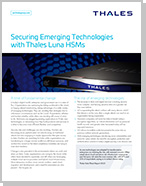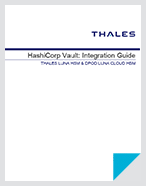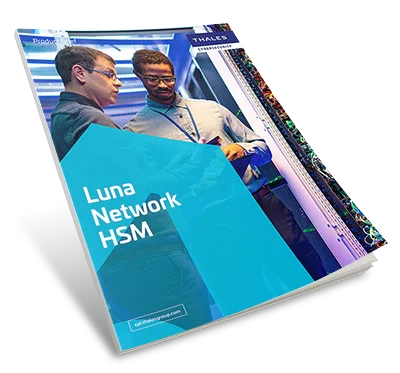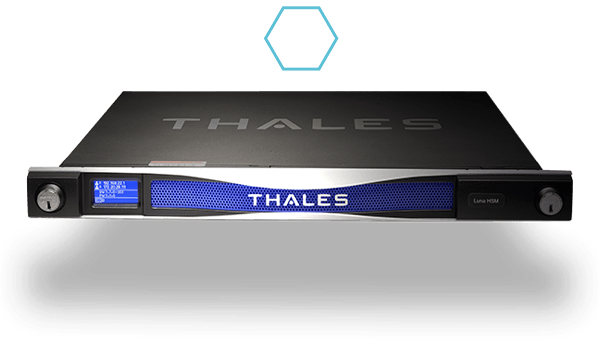TalkingTrust with Thales and HashiCorp – DevSecOps
 As organizations adopt DevSecOps principles for rapid application delivery, they are heavily leveraging HashiCorp vault to centrally manage and deliver appropriate secrets to the applications. Vault stores thousands or even millions of highly sensitive secrets in such environments and encrypts them in storage to prevent any unauthorized access. Thales HSM solutions encrypt the Vault master key in a hardware root of trust to provide maximum security and comply with regulatory requirements. In this video, we discuss how organizations can enhance vault’s security controls by leveraging Thales Luna HSM to meet the most stringent compliance regulations & automate their DevOps processes.
As organizations adopt DevSecOps principles for rapid application delivery, they are heavily leveraging HashiCorp vault to centrally manage and deliver appropriate secrets to the applications. Vault stores thousands or even millions of highly sensitive secrets in such environments and encrypts them in storage to prevent any unauthorized access. Thales HSM solutions encrypt the Vault master key in a hardware root of trust to provide maximum security and comply with regulatory requirements. In this video, we discuss how organizations can enhance vault’s security controls by leveraging Thales Luna HSM to meet the most stringent compliance regulations & automate their DevOps processes.
In this video, Thales and HashiCorp discuss how organizations can meet the most stringent compliance regulations and automate their DevOps processes by utilizing Thales HSMs to securely store the private keys to their HashiCorp Vault.
Speakers:
Dave Madden, Director of Business Development at Thales
Chintan Gosalia, Sr. Solutions Engineer at HashiCorp
Review all integrations and supporting documents for Thales with HashiCorp.
Thales Technology Partner: cpl.thalesgroup.com/partners/hashicorp
Partner website: www.hashicorp.com

Resources:
Video Transcript
TalkingTrust Series - HashiCorp - DevSecOps
00:10 Good morning everyone
00:11 and welcome to this webinar hosted by
00:13 Thales and HashiCorp.
00:15 My name is Chintan Gosalia and I'm a
00:17 Senior Solutions Engineer
00:19 at HashiCorp. Previously I also worked for Thales,
00:23 so I'm super excited to be working on
00:25 this webinar with the team there.
00:28 I agree. My name is David Madden and I’m
00:30 thrilled to be here with Chintan today to talk about
00:33 applying roots of trust for devops secrets in Vault
00:37 using an HSM. Today in this webinar we're
00:40 going to plan and discuss a number of things,
00:43 including a very interesting challenge that we're
00:46 seeing out there in the world with
00:47 secrets sprawl that
00:49 a lot of our large organizations are running into.
00:52 We're also going to talk about how
00:54 organizations can address this with HashiCorp Vault
00:57 Secrets Management, and also how they can
01:00 leverage an HSM as a root of trust to
01:01 protect these secrets stored in the Vault,
01:04 as well as ensuring automation for devops.
01:07 According to our friends at IDC, one of the things
01:10 organizations see as they digitally transform
01:14 is the shift from a service provider
01:16 approach to a core part of the digital
01:18 value chain creation,
01:19 making devops what Hashi and Thales do a
01:22 core asset of any business in the digital economy.
01:25 So we're going to talk about this, talk about that impact
01:28 to really every organization that's digitally transformed.
01:31 So let's get started on this TalkingTrust
01:33 with Thales and HashiCorp,
01:35 and I think the first place maybe we do
01:37 that Chintan is the is around
01:39 secret sprawl, which is on a lot of
01:41 people's minds today. Can you
01:42 describe it in a little more detail
01:44 what's causing secret sprawl?
01:48 That's a great question David. We all know that to thrive
01:52 in today's digital economy every organization
01:55 is heavily investing into digital transformation.
02:00 The goal of this transformation is to accelerate building
02:03 and delivery of applications to its customers,
02:07 and the two critical components to
02:09 achieve this acceleration are:
02:11 number one transition to the modern data center
02:15 that provides on-demand resources; and number two
02:18 adoption of agile and automated devops workflows.
02:23 Now this transition has created a unique
02:26 challenge of secret sprawl.
02:28 For example as a team dynamically scales
02:31 up the number of app servers
02:33 due to increased demand, these newly
02:36 provisioned app servers
02:37 need username and password to connect to
02:40 the database servers.
02:42 A Jenkins server may need to inject a GitHub API key
02:46 in its Ci CD pipeline, or they may also have micro services
02:50 that need tokens and certificates to
02:53 securely connect and communicate with each other.
02:57 The outcome is a lot more sensitive
03:00 secrets to manage
03:01 than they ever had, due to the automated
03:04 dynamic workflows.
03:09 In a recent survey 81 person organizations confirm
03:13 that they have experienced secret sprawl,
03:16 and worry about leakage or
03:18 compromise of secrets that can lead to a breach.
03:22 Traditionally the organizations relied
03:24 on storing the secrets in plain text,
03:27 either in config files, application code,
03:30 or even providing secrets manually by human operators.
03:35 This was an acceptable risk in a static
03:38 and high trust network
03:40 in the four walls of a data center,
03:43 but the infrastructure in public clouds
03:45 are no longer owned by
03:47 application owners and without any defined boundaries.
03:51 Networks are considered low trust or zero trust,
03:55 so call these secrets in plain text in
03:57 some files or code.
04:00 What is required is a shift in our
04:02 secret management approach.
04:04 A solution that securely stores secrets,
04:07 and relies on service based identity
04:10 to deliver them to applications in an automated manner.
04:14 Right. Thank you Chintan. So now that we
04:18 understand why these customers are looking at secrets
04:20 and using them in so many different ways,
04:23 enabling them to really achieve
04:25 the benefits of digital transformation automation
04:28 and cloud native, now I think we should probably
04:31 discuss more about how they should best
04:33 approach implementing this
04:35 in a secure and of course a scalable way.
04:38 Can you share some details about how
04:40 Hashi’s approaching this?
04:42 Yeah another great question David. The
04:45 challenges we discussed
04:46 are why HashiCorp Vault has become a
04:49 de facto standard
04:50 for secret management in a multi-cloud
04:53 environment with devops workflows.
04:56 Its success can be attributed to its
04:58 three core principles.
05:00 The first one is extensible architecture.
05:03 Vault supports a variety of secrets
05:06 through its secrets engines.
05:08 For example, a PKI secrets engine can
05:11 dynamically generate digital certificates.
05:14 KV secrets engine can store any static secrets.
05:18 And MySQL secrets engine can dynamically
05:20 generate MySQL database credentials.
05:24 There is a secret engine available for
05:26 any well-known type of secret
05:28 and its workflow. This extensible and
05:31 pluggable architecture
05:33 allows Vault to provide a single pane of glass
05:37 to manage any secrets in any environment.
05:42 The second principle is its ability to secure
05:45 with any identity. Vault integrates with pretty much
05:49 all popular identity providers, for example
05:53 a client can authenticate with Vault using its
05:56 GitHub credentials when requesting a secret.
06:00 In a development environment, the same client can use
06:03 Okta or AD credentials when requesting a secret
06:07 from a corporate network, or use AWS IM credentials
06:12 for a secret in the AWS environment.
06:15 This allows Vault to provide secrets to any client
06:19 in any environment.
06:22 The third principle is its API-first approach.
06:26 Every operation in the world is
06:29 available through a CLI
06:31 and API, and hence it seamlessly integrates
06:35 with any existing human or devops workflow.
06:40 Nice. Now I see why organizations are adopting Vault
06:43 to effectively manage their secret
06:45 sprawl. You know, leveraging these capabilities.
06:48 But doesn't that now make Vault a target
06:51 as it now stores the crown jewels to the
06:53 organization's devops infrastructure?
06:56 Can you tell us how Vault can help address this risk?
07:00 Yeah, it definitely does, and to address this risk
07:03 Vault encrypts all its data in storage
07:06 with an encryption key.
07:09 This encryption key is then encrypted with a master key,
07:13 which is then protected by another key
07:15 known as an unseal key. This unseal key
07:19 can be referred to as the root of trust
07:21 for Vault, as it allows the Vault to
07:24 unlock all secrets stored inside it. This is why
07:28 it is very critical to protect
07:30 this unseal key. Right, so I guess now the
07:33 question in the minds of
07:35 of our listeners is how does Vault
07:37 protect this unsealed key.
07:40 Yeah, in its default configuration wall protects
07:44 the unseal key using Shamir’s secret sharing.
07:48 The unseal key is split into N different key shares.
07:53 Each key share is then provided to a
07:55 separate key custodian, so there are N key custodians
08:00 each knowing a part of the key instead
08:02 of a single person knowing the entire key value.
08:07 A certain threshold of shares also known as K
08:11 is required to reconstruct the unseal key.
08:14 The default value of N is five and K is three,
08:18 so at least three out of five key
08:20 custodians are required
08:22 to reconstruct the unseal key.
08:25 Whenever a Vault is started, K number of
08:28 key custodians
08:30 must provide their key shares to
08:32 recreate the unseal key.
08:34 They will decrypt the master key which
08:36 will allow Vault to decrypt secrets,
08:39 and fulfill any requests coming from authorized clients.
08:44 This is a secure process as no single key custodian
08:48 knows the unseal key, but there are a
08:51 couple of considerations to using Shamir’s
08:53 secret sharing as the root of trust for Vault.
08:58 First, it makes starting or restarting
09:01 Vault a manual process.
09:04 Vault may need to be restarted at odd
09:06 hours due to outages
09:08 or planned maintenance activities, and using
09:11 Shamir’s secret sharing as a root of trust will require
09:14 a human intervention during such events.
09:19 Second, the unseal key is generated using
09:22 Vaults software crypto libraries.
09:25 Many organizations have strict security requirements
09:29 to leverage FIPS 140-2 Level 2
09:33 or Level 3 validated hardware devices
09:36 to generate and manage such critical encryption keys.
09:40 Ah, this is really good to know, thanks
09:41 for sharing that. And as you have mentioned,
09:44 many organizations require an automated unseal process
09:47 and a hardware-based root of trust can
09:49 help meet their compliance requirements as well.
09:52 And this is where Thales and HashiCorp
09:55 work together to provide an enhanced
09:57 HSM-based root of trust. Can you tell us
09:59 a little bit more about how this
10:01 integration works? Yes, the organizations
10:04 can leverage Thales Luna HSMs as the root of trust
10:08 instead of Shamir's secret sharing.
10:11 In this configuration the responsibility
10:14 of securing the unsealed key
10:16 is delegated from users to a highly secure
10:20 and trusted Thales Luna HSM.
10:24 The unseal key here is generated and stored
10:27 only within the secure boundaries of a Luna HSM.
10:31 At startup, Vault will connect to a Luna HSM
10:35 via PKCS#11 API, and ask it to decrypt the master key.
10:42 As this process doesn't require any human intervention,
10:46 it is also referred to as automated unseal for Vault.
10:51 The unseal key also never leaves HSM,
10:55 and hence not subject to unauthorized access
10:58 or leakage due to a human error.
11:04 Now let us review some of the benefits of leveraging
11:08 Thales Luna HSM as the root of trust
11:11 versus Shamir’s secret sharing.
11:14 The first benefit as we discussed is
11:16 automated unsealing,
11:19 it also improves the Vault security posture
11:22 as it eliminates any human errors around
11:25 securely storing and managing Vault unseal keys.
11:30 Second - Luna HSM is a FIPS 140-2
11:34 Level 3 and Common Criteria certified device,
11:38 and meets the most stringent security standards
11:41 for generation and management of encryption keys.
11:45 This enhances the root of trust security for Vault,
11:49 and all the secrets stores inside it.
11:53 With Luna HSM as the root of trust,
11:56 Vault can also supplement
11:58 its system entropy with entropy from
12:01 Thales Luna HSM.
12:03 This can be quite critical for organizations
12:07 where alignment with cryptographic regulations like
12:10 NIST SP 800-90B is required,
12:14 or augmented entropy from hardware to random number
12:18 generators are desirable.
12:22 We typically see this as a requirement
12:24 for many of our Government
12:26 or Financial Services customers.
12:30 Vault can also leverage seal wrapping functionality
12:34 from Luna HSM, where it will store
12:37 its critical security parameters in a manner
12:41 that is compliant with key storage and
12:43 key transit requirements.
12:46 So in a nutshell, Luna HSM based root of trust
12:50 allows an organization to gain better security posture for
12:55 secrets stored in the Vault, while
12:57 benefiting from a highly operate
12:59 automated operational workflow.
13:04 Thank you for walking through this with us Chintan.
13:07 So let me see if I can summarize.
13:09 Typically, as we know,
13:10 security hinders automation and scale
13:13 and so this has been avoided
13:15 really at all costs until required by developers.
13:18 Additionally we're seeing the need for open source
13:22 APIs, CLI, and a broad ecosystem to ensure
13:25 a strong digital innovation for enterprises.
13:28 and so these things have been challenged
13:30 in the past, and now with the combination of Hashi Vault
13:33 and the Thales Luna HSMs, we have a strong
13:35 partnership that really empowers organizations
13:38 to meet their automation security and
13:40 compliance requirements such as FedRAMP, GDPR,
13:45 PCI-DSS, digital signatures, code signing
13:48 and data encryption. And together we
13:51 enable the vision of devops in a secure
13:52 and efficient manner,
13:54 with the foundation of digital trust. And
13:56 to put this all in the context of the global pandemic,
13:59 IDC have found that teams practicing accelerated
14:04 application delivery and devops were in the position
14:08 to use software innovation and agility impact or
14:11 response to the crisis. They were
14:14 able to better roll out new releases in
14:15 a much shorter time,
14:16 and help drive the shift to a digital business.
14:20 So, we hope you're staying safe and
14:21 leveraging Hashi and Thales to support
14:23 your business plans in 2021
14:25 with our combined foundation of digital trust.
14:29 Okay, so with this we reached the end of
14:32 our talk. I hope you found this helpful
14:34 and if you have any questions please
14:36 feel free to reach out to the Hashi
14:38 team at hello@HashiCorp.com, or the Thales
14:41 team at cpl.thalessgroup.com.
14:44 You can also feel free to send Chintan or I emails,
14:48 and we'll be happy to respond and follow
14:50 up. Thanks again for your time
14:52 Chintan, and I hope people have enjoyed
14:55 this. Have a great rest of the day.
14:56 Thank you David.

Enhanced Data Security with HashiCorp Vault and Thales HSMs - Solution Brief
Organizations today are faced with a paradigm shift where data is becoming the core of their business. As information increases in volume and value, enterprises are overwhelmed with the challenges of protecting and managing data sprawl. The problem of data protection is...

Securing Emerging Technologies with Thales Luna HSMs - Solution Brief
In today's digital world, enterprise and government are in a state of flux. Organizations are optimizing by taking workloads to the cloud, or forging ahead transforming, taking advantage of a wide variety of emerging technologies. They are revisiting their strategies due to...

HashiCorp Vault with Thales Luna HSMs - Integration Guide
This document describes how to store the HashiCorp Vault encryption key on a Thales Luna HSM or Luna Cloud HSM service and to leverage HSM for entropy augmentation. HashiCorp Vault Enterprise allows HSM support as a feature. It uses the HSM for: Master Key Wrapping:...

Luna Network HSM - Product Brief
Secure your sensitive data and critical applications by storing, protecting and managing your cryptographic keys in Thales Luna Network Hardware Security Modules (HSMs) - high-assurance, tamper-resistant, network-attached appliances offering market-leading performance and...

